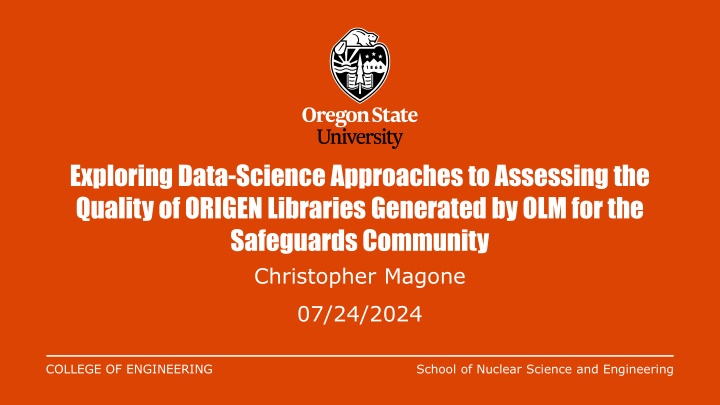
Assessing Quality of ORIGEN Libraries Generated by OLM
Explore data science approaches for automating library quality assessment in ORIGEN libraries created by OLM within the nuclear fuel cycle modeling context. The goal is to increase computational efficiency and demonstrate automated assessment processes.
Download Presentation

Please find below an Image/Link to download the presentation.
The content on the website is provided AS IS for your information and personal use only. It may not be sold, licensed, or shared on other websites without obtaining consent from the author. If you encounter any issues during the download, it is possible that the publisher has removed the file from their server.
You are allowed to download the files provided on this website for personal or commercial use, subject to the condition that they are used lawfully. All files are the property of their respective owners.
The content on the website is provided AS IS for your information and personal use only. It may not be sold, licensed, or shared on other websites without obtaining consent from the author.
E N D
Presentation Transcript
Exploring Data-Science Approaches to Assessing the Quality of ORIGEN Libraries Generated by OLM for the Safeguards Community Christopher Magone 07/24/2024 COLLEGE OF ENGINEERING School of Nuclear Science and Engineering
Motivation Reactor library creation requires extensive experience with the SCALE code system ORIGEN Library Manager (OLM) created to enhance ease-of-generation and ease-of-use for ORIGEN libraries used in nuclear fuel cycle modeling
Goals Develop code within the existing OLM framework to automate library quality assessment Increases computational efficiency through removal of extraneous grid points within interpolation meshes Demonstrate automated library quality assessment
Background: ORIGEN Reactor Library Creation Determine which interpolation dimensions capture important spectral effects within design and operating conditions Create a grid for interpolation space and perform depletion calculation at each grid point Combine resultant assembly-average libraries into single ORIGEN reactor library
OLM Automation Process Based on user-defined model and interpolation space configuration: 1. Generate 2. Run 3. Assemble 4. Check 5. Report
Model & Interpolation Parameters W17x17 pin cell with uranium oxide (uox) fuel Pitch: 1.26 cm Fuel pellet radius: 0.4095 cm(?) Clad outer radius: 0.475 cm(?) Parameters: coolant density, enrichment, and burnup steps
Method Using modified OLM code: Run OLM with base set of interpolation parameters Re-run assemble mode with specified points removed from parameter mesh ( modified set) Compare ORIGAMI results from both base and modified runs Looking at percent error between data at corresponding grid points Isotopes of interest; Cs137, Eu154, Nd148
Results: Modified Coolant Density Configuration Burnup grid: 12 unevenly spaced points between 0s and 2.376 108s (7.529 yrs) Enrichment: 3.0% Base coolant density [g/cc]: 7 points in 0.70,0.76 , with 0.01 spacing Modified coolant density: base with every other point removed Max error = 1.674 10 4%
Results: Modified Enrichment Configuration Burnup grid: 12 unevenly spaced points between 0s and 2.376 108s (7.529 yrs) Coolant density: 0.7 g/cc Base enrichment [%]: 14 points in 0.5,7.0 , with 0.5 spacing Modified enrichment: base array with every other point removed
Results: Modified Enrichment Configuration Coolant density: .7% Enrichment: 3 g/cc Base burnup grid: 12 unevenly spaced points between 0s and 2.376 108s (7.529 yrs) Modified burnup: base array with every other point removed (keep_every=2)
Results -Continued Removal of grid points from parameters yielded a total maximum error of 9.021 10 2 across the individual cases. Sufficiently small for this chosen model Max Error in ORIGEN results Modified Coolant Density 1.674 10 4 1.154 10 4 1.633 10 4 Modified Enrichment 2.575 10 3 9.021 10 2 2.722 10 3 Modified Burnup 5.0 10 5 1.55 10 3 2.0 10 5 Cs137 Eu154 Nd148
Future Plans Expanding capabilities to coarsen in multiple parameter dimensions simultaneously Consideration of assembly-level model Addition of gadolinium loading as interpolation dimension Investigation into data science driven approaches to assessment of grid refinement
